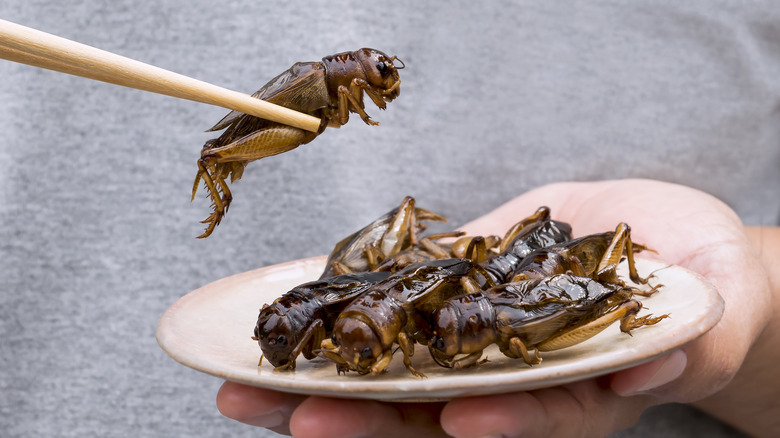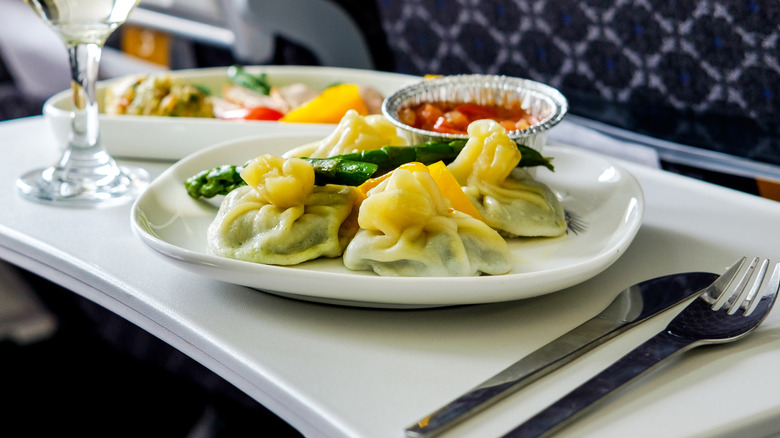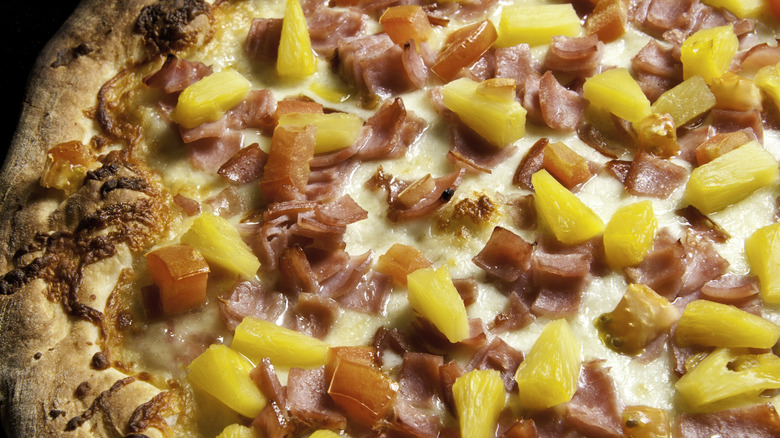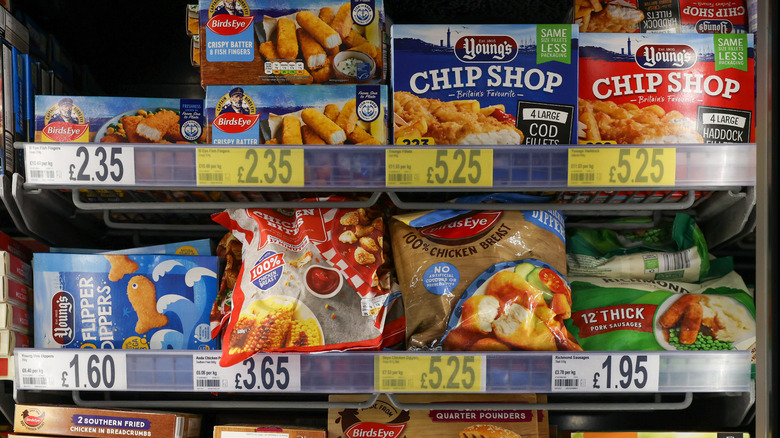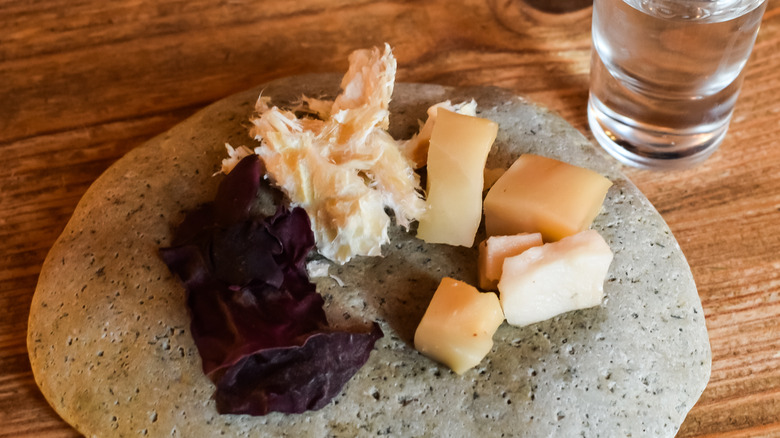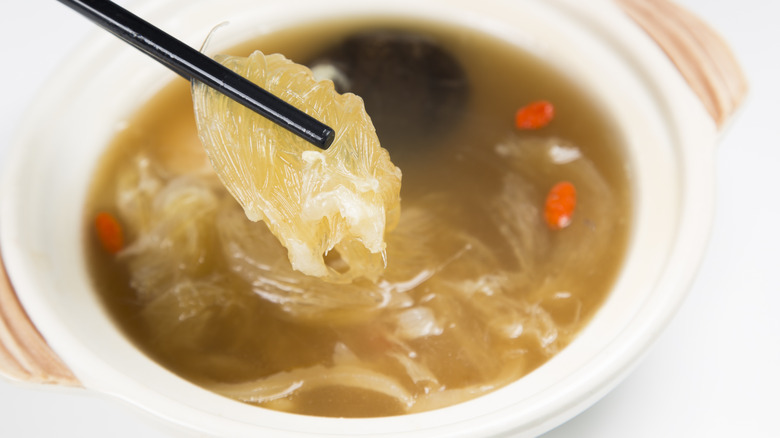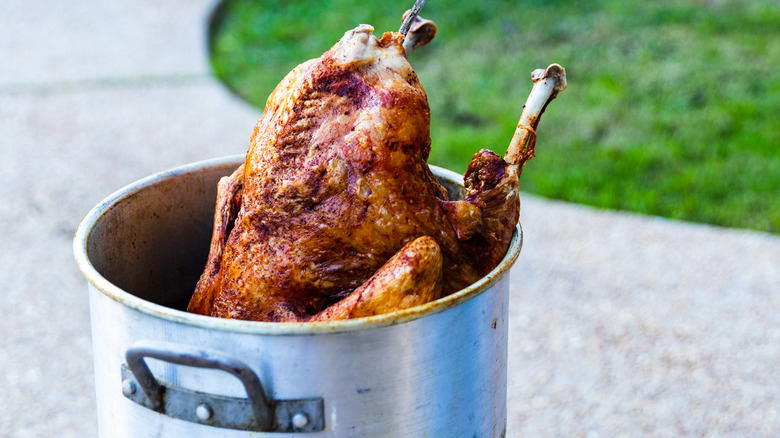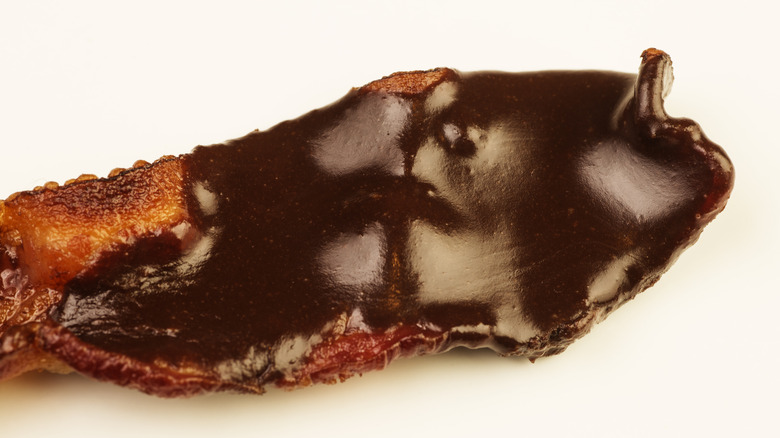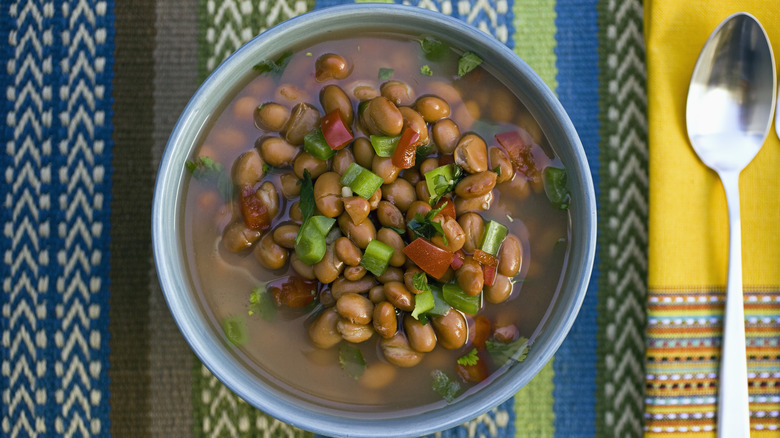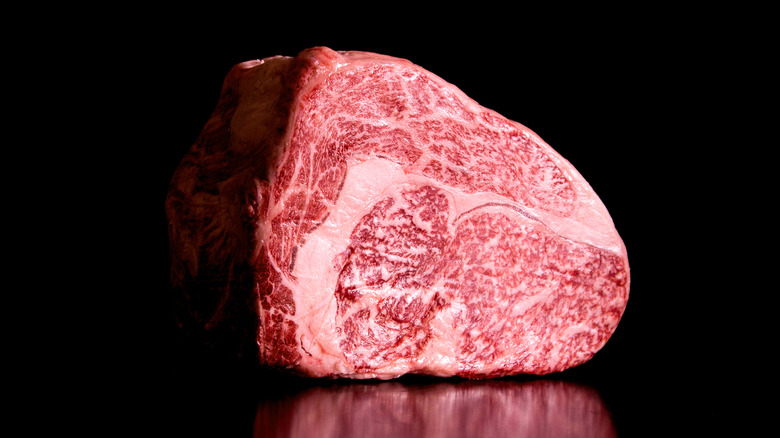10 Foods That Gordon Ramsay Doesn't Dare To Eat
Whether it's as the host and judge of cooking competition shows like "Hell's Kitchen" and "MasterChef," or acting as a culinary consultant in his duties as the star of "Kitchen Confidential," Gordon Ramsay willingly (and bravely) exposes himself to a lot of potentially terrible eating situations. Watch any of his shows for more than a few minutes and you are likely to encounter Ramsay angrily spitting out something for being overcooked, undercooked, too salty, not salty enough, rotten, or for another fault that can provoke such a reaction, along with a lot of swearing.
And yet Ramsay is more than just a human way-station for terrible cooks and their horrible, barely edible concoctions. He's passionate and curious about food, and his training, TV travel shows, and just plain dining out all over the world have landed him face to face with almost every comestible under the sun. He's a famous chef and a marvelously successful restaurateur, but he's still a human being. Everybody has certain foods or categories of foods that they simply will not touch, even someone like Ramsay. Here are all the things that Gordon Ramsay flat-out refuses to consume.
Insects
Consuming bugs is a hard concept for a lot of people to wrap their heads around. Even though plenty of us view insects as creepy, crawly, or even poisonous little predators, many species and types of bugs are safe to eat and boast a protein-per-ounce level that's comparable to that of chicken, pork, or beef, according to BuzzFeed News. (National Geographic recommends the consumption of ants, bees, wasps, grasshoppers, crickets, locusts, and beetles, among others.)
Insects are extremely plentiful, and according to the Science Museum of Virginia, they're part of the regular diet of about two billion people worldwide. TV food host and renowned chef Gordon Ramsay isn't part of that sizable group, and he isn't likely to be anytime soon. In a 2019 episode of his travel series "Uncharted," a guide in Peru helped Ramsay take down a cliffside cactus so they could feast on the Peruvian cactus worms that infested the plant. Ramsay helped prepare and cook the worms in oil and when they were ready, he put one in his mouth. Ramsay chewed it for a second, then turned away from his host and violently spit the food out. He likened the taste of the meal to "a crispy cockroach."
Airplane food
Back in the days in which at least moderately lengthy airplane trips included a free meal, according to The Washington Post, it became a cliche or assumption that such fare was bland, tasteless, and all-around terrible. Airplane food once came pre-cooked, in small portions, served on a little tray, and consisted of the most middle-of-the-road foods conceivable to please (or at least not offend) as many travelers as possible. Meals are still available on flights, but they now are more likely to cost an additional fee. Moreover, it's likely to be something unimpressive like a sandwich or snack plate — not unlike what can be bought in an airport before taking off.
This is basic food that satisfies hunger, and it doesn't need to be much more than that, but Gordon Ramsay loathes it in all its shapes and forms. That's especially true because he's familiar with the dirty work of how it's produced. He told Refinery29, "I worked for airlines for 10 years, so I know where this food's been and where it goes, and how long it took before it got on board." Ramsay went so far as to open a restaurant in London's Heathrow Airport to provide travelers with elevated, on-the-go fare. He named it Plane Food.
Pineapple pizza
Pizza toppings are among the most polarizing and hotly debated subjects in all of food-dom. There are near-universal favorites, like pepperoni, extra cheese, or sausage. Then, there are the ones that seemingly no one will admit to liking, such as anchovies. Right in the middle, with passionate advocates and vocal haters alike, is pineapple. Some people think a little bit of sweetness offsets a rich and savory pizza quite nicely, while others find it to be a disjointed mashup of ingredients that just don't go together. Chef Gordon Ramsay is solidly in the latter camp.
"Pineapple does not go on top of pizza," he emphatically and drolly stated on Twitter in 2017. Months later, while hosting "The Nightly Show" in the U.K., Ramsay set up a comedy bit where he ordered a huge amount of pizzas, and while on the phone with the parlor, took suggestions. He jokingly chastised a member of the audience who suggested pineapple. His final order: "Ten Margarita, ten pepperoni, and no pineapple anywhere. Definitely no pineapple."
Frozen food
Though it's now taken for granted as a widely available, relatively inexpensive source of nutrition and sustenance, frozen food is nothing short of a miracle of science and a relatively new technology. According to the Library of Congress, the first frozen foods were developed in 1924. But while freezing allows for widespread distribution of food and an immensely increased shelf life, it doesn't always taste as good as its fresh or scratch-prepared equivalents. A frozen spaghetti dinner or fried chicken just isn't going to be as tasty as their fresh homemade versions. That's a closely-held truism for Gordon Ramsay in particular.
In a 2009 interview, Bon Appétit asked the chef and TV personality if there were any foods that he refused to eat. "Any ready meal," Ramsay replied, referring to frozen dinners. "It's so easy to prepare a quick meal using fresh produce, such as a simple stir-fry, but people still resort to ready meals that all taste exactly the same." Even the perpetually busy Ramsay finds no excuse for a frozen meal or even frozen ingredients.
Hákarl
Per Atlas Obscura, the Greenland sharks that swim in the chilly waters surrounding the nation of Iceland can grow to a length of 24 feet. That provides a lot of meat, but it's not immediately consumable. This shark flesh is poisonous to humans, but about a millennium ago, Vikings in the area discovered that the toxins could be removed if they undertook a laborious process. This meant that they had to cut the meat into chunks, store it under rocks, and bury it all underground for several weeks. At that point, they'd dig the meat up and hang it up to age in a shack. The resulting food is known locally as hákarl. This fermented shark meat smells like ammonia and tastes caustic, bitter, cheesy, and fishy.
On a 2021 episode of his travelogue series "Uncharted," according to People, Ramsay visited Iceland during the national historical and cultural festival of Thorrablot, when hákarl is traditionally prepared in large numbers. "I'm in Northwest Iceland sampling a pungent slice of fermented shark that I'm not convinced is meant to be eaten," Ramsay explained to viewers before giving himself a pep talk to convince himself to try a bite of hákarl. He couldn't do it — he immediately spit out the tiny piece he'd placed in his mouth. "My nose is all fizzy," he said, before declining a second piece.
Shark fin soup
In 2011, Gordon Ramsay filmed a TV documentary called "Shark Bait," a rundown of an investigation into the history and practice of shark fishing. According to the series, shark fins are considered an ancient delicacy in China, most commonly prepared as the chief ingredient in a soup. The industry that supports the widespread consumption of shark fin soup leads to the deaths of around 100 million sharks every year. It's led to the extinction of many species of the aquatic animal. According to Scientific American, the practice was outlawed in the U.S. in 2010 but continued elsewhere in the world. Ramsay filmed his special in part to shine a light on what he considered to be the dark and destructive practice of shark fin harvesting.
He opposes shark fin soup in principle, and while making the show, he was even attacked by shark fin cartels. According to The Telegraph, shark fishing gangs work out of heavily guarded and armed compounds. When Ramsay tried to access one, a guard dumped gasoline on him. In a separate incident, a shark-fin group briefly held the chef at gunpoint, likely further dampening his appetite for any meal incorporating shark fin.
Deep fried turkey
A massive feast is central to multiple end-of-the-year holidays in both the United States and the United Kingdom — namely, Thanksgiving and Christmas in the former, and Christmas in the latter. The central entree that all the side dishes accompany is, traditionally, historically, and popularly, a turkey. It's often consumed for both Thanksgiving dinner and Christmas lunch. There are lots of ways to prepare the bird, from roasting to grilling. According to Vogue, the deep-fried turkey is a late-breaking method that involves submerging the oftentimes humongous bird into a very large container filled with piping-hot cooking oil. If done right, it cooks the turkey thoroughly in less time than it takes to roast while also giving the meat a deliciously crispy skin.
Yet Gordon Ramsay isn't a fan of turkey cooked in a big pot of oil. "I went round to someone's house, a friend of mine in L.A. for Thanksgiving, and he started going to the garage for preparation of the lunch," Ramsay explained on "The Late Show with Stephen Colbert." As Ramsay continued, "And there's this big vat and he wheeled this big bird down and deep-fat fried this thing," which he described as "disgusting." The chef's biggest problem with the turkey was more than skin-deep, however: he found the result to be exceedingly dry.
Chocolate and bacon together
One of the biggest food trends in the past couple of decades, according to Time, is adding bacon to everything. Meanwhile, humanity's deep and passionate love for chocolate, not to mention dipping anything in chocolate, remains a near-constant in both packaged and restaurant food. These two worlds of bacon and chocolate collided when enterprising chefs combined the two to create a theoretically pleasing blend of salty, savory, and sweet. On a 2017 episode of his advisory-and-criticism reality show "Hotel Hell," Gordon Ramsay paid a visit to The Merk, an Italian-inspired bistro in San Diego that was falling apart from the inside out. One of the restaurant's signature dishes was a dessert called the Chocolate Pig — a pizza-like flatbread made with white and dark chocolate, along with sliced strawberries and bacon.
Even before he tasted it, Ramsay seemed openly revolted by the idea of chocolate and bacon playing together. "It's like we've had a crisis with the toilet paper department," he quipped about the concoction smeared with brown chocolate, referring to it as incredibly unappetizing. Despite his initial assessment, Ramsay took one bite of the chocolate and bacon-laden pizza ... and spit it out in full view of The Merk's kitchen staff.
The soup of the day
As a cook who worked his way up through the ranks of restaurants and eventually became a chef and then the owner of many restaurants, Gordon Ramsay knows all the ins and outs of how eateries operate. This also means that he is keenly aware of the questionable or objectionable things that chefs and restaurants are willing to do to stretch ingredients or save a buck. He takes that knowledge with him when he's dining out, and that's why he doesn't want to hear from his server about the daily specials. As Ramsay will colorfully tell you, he's certainly not going to order them.
"Ask what yesterday's soup du jour was before today's special," Ramsay told Town & Country in 2017. "It may be the case that it's the soup du month." Without pointing fingers or naming names, Ramsay is heavily implying that restaurants, particularly cash-strapped ones, or establishments operating on a razor-thin profit margin, will creatively reuse foods or ingredients that aren't selling briskly. The soup of the day might be the same soup of the day many times over, at least until the restaurant runs out of it. In Ramsay's opinion, it may stay on the menu well beyond after it tasted freshest or best. Ramsay wants no part of that.
Fancy trendy foods
Gordon Ramsay's personal tastes tend toward the old-fashioned. He's spoken about his abiding love for beef Wellington, for example, and he told "The Late Show with Stephen Colbert" (via Food & Wine) that one of his favorite American dishes is the Southern staple of shrimp and grits. So, it's not surprising to learn that the chef is a little wary of faddish ideas that haven't weathered the test of time or outgrown their hype.
When asked by PopSugar to name the food trends he found the most loathsome, he answered, "Foams." An outgrowth of the molecular gastronomy movement, which uses scientific manipulation to change the physical makeup of food, foams can be made out of almost anything. But Ramsay can only handle the sweet ones. "I was in Saint Paul, and someone gave me a bone marrow foam," he explained, adding that he also doesn't like foams because "Sometimes they look like toxic scum in a stagnant pool."
Nor is Ramsay impressed by the rise — and breathless promotion — of Wagyu beef as an ingredient. A rare and specific cut derived from a small population of Japan-raised cattle, it's tender and excellently marbled. What's more Ramsay's menus have been known to include Wagyu meatballs. But he's not interested in other chefs' takes, particularly if they're unimaginative or lazy. "It needs to be treated with a little bit of respect," he said of the pricey ingredient. "Preserve it a little bit. Rest it. Allow it to become special."

